AI Meme Drives the Iteration of AI Agents; A Single AI Agent Struggles to Meet Market Demands, Cross-Domain Integration Will Become a Necessity.
Written by: CoinW Research Institute
Key Points
Traditional AI is very effective in many scenarios, but its limitations such as high centralization and high costs make it perform poorly in dynamic, decentralized, and real-time decision-making environments. AI agents combined with cryptocurrency can compensate for these shortcomings, as these agents possess higher autonomy, adaptability, decentralization, and multitasking capabilities, playing a key role in complex economic models and real-time decision-making, thereby optimizing the overall operational efficiency of the AI system.
The AI Agent framework is the infrastructure for AI Agents and an important development direction in the AI Agent space. Currently, representative projects include ai16z, zerebro, and arc. ai16z is based on the Eliza framework, which has been open-sourced on GitHub. The Eliza framework is widely used in various agent applications, including wallets, social integration, and customizable agents, making ai16z regarded by the community as a representative project of the AI agent framework. The framework of zerebro is ZerePy, an open-source Python framework, initially focused on incentivizing user participation in X, with plans to expand to other platforms and support integrated memory and local LLM in the future. However, the product has not yet been launched and requires further observation. arc is currently the only project based on the RIG framework and is still in the early stages of development. Considering that the currently most widely used Eliza framework is a lightweight foundational framework, upgraded versions of framework representative projects may emerge in the future.
In the direction of AI Agent asset issuance, notable examples include Virtuals Protocol and clanker on the Base chain, Dasha on the Solana chain, and AigentFi on the ZKsync chain. Virtuals focuses on the underlying foundation for entertainment and virtual agent issuance, with 12,069 existing ecosystem projects; clanker is positioned as the Pumpfun of the Base ecosystem, with 17,242 existing ecosystem projects; Dasha is positioned as the Pumpfun of the Solana ecosystem, with 2,401 existing ecosystem projects; AigentFi, based on the ZKsync chain, is positioned as the agent for all AI agents, with 55 existing ecosystem projects. As of the time of writing, the total market capitalization of the Virtuals ecosystem token is $3 billion, with the top three tokens being VIRTUAL with a market cap of $2.4 billion, AIXBT with a market cap of $230 million, and GAME with a market cap of $90 million. The total market capitalization of the clanker ecosystem token is $11 million, with the top three tokens being CLANKER with a market cap of $51.86 million, ANON with a market cap of $18.75 million, and LUM with a market cap of $12.18 million. Dasha and AigentFi are relatively lagging in development, with corresponding platform token market caps of $5.02 million and $1.6 million, respectively.
In the direction of AI Agent engines, representative projects include griffain on the Solana chain and Spectre AI on the ERC-20 chain. The core concept of griffain is to directly turn users' thoughts into actions, evolving from a read-write model to a read-write-action model. griffain has also received official support from Solana and has helped humans shop through the agent. GRIFFAIN was released on November 3, with a current market cap of $270 million. Spectre AI is an on-chain search engine based on ERC-20, with its core mechanism providing users with comprehensive insights into cryptocurrency data. Spectre AI was born in 2023 and transitioned from an AI prediction bot to an on-chain search engine project in May 2024. Compared to Spectre AI, griffain has a slight edge in overall project narrative and ecosystem development.
In the direction of AI Meme, represented by GOAT, AI Meme is a new engine for the combination of AI and Crypto, and has become an indispensable part of the market. GOAT, TURBO, and BULLY are representative projects of AI Meme. As of the time of writing, Wintermute remains the third-largest holder of GOAT, holding 4.66% of the total supply. The methods of AI Meme are also gradually diversifying, with projects attempting to generate memes/images/music, but the market shows clear signs of fatigue. The direction of AI-generated memes still requires more external traffic injection.
In addition to the major directions mentioned above, there are also some interesting observable directions. For example, the AI analytical agent aixbt and the comprehensive agent Simmi; compared to aixbt, SIMMI's main advantage is its broad range of settings, not limited to specific fields; the combination of AI Agent and DeFi, AiFi Mode, aims to achieve interaction from artificial intelligence to artificial intelligence, thereby expanding the boundaries of DeFi, allowing intelligent agents to autonomously execute complex financial tasks; the AI Agent falsification direction Seraph, which is an AI Agent jointly released by the Virtuals and TAO subnet communities, with its main income source being token income from verification, though the product has not yet been released; the AI Agent real-time API direction Creator.Bid, which has received support from well-known VCs such as Mechanism Capital, Zee Prime Capital, and Moonrock Capital. On December 10, Creator.Bid was sold on FjordFoundry but faced a DDoS attack, yet the community remains optimistic. Currently, Creator.Bid operates mainly through a points system, and the next sale plan has not yet been announced.
With the continuous emergence of AI Agents, infrastructure will become the market winner; as infrastructure matures, more applications will shift from speculation to value realization; AI Meme will become an indispensable part of the market, driving the iteration of AI Agents; a single AI Agent struggles to meet market demands, and cross-domain integration of AI Agents will become a necessity.
I. Cryptocurrency is the New Engine for AI Agents
The artificial intelligence market is rapidly growing. According to research data from Mordor Intelligence, it is expected to reach a market value between $780 billion and $990 billion by 2027, with a compound annual growth rate (CAGR) of 40% to 55%. Sam Altman stated that 2025 is the time when agents will start working, and the era of AI Agents is approaching.
While traditional AI is very effective in many scenarios, its limitations such as high centralization and high costs hinder its evolution. OpenAI's GPT-4 used an estimated $78 million worth of computing resources for training, while Google's Gemini Ultra had a computing cost of $191 million.

Source: 2024 AI Index Report
High centralization: Traditional AI technologies and platforms are monopolized by a few tech giants, which limit competition from other companies through technological barriers and data advantages, leading to market inequality. Additionally, traditional AI systems often rely on centralized data processing and decision-making, with all computations and decisions concentrated in a central server or system. This can lead to bottlenecks, inefficiencies, or over-reliance on a single control point in certain cases.
Moreover, traditional AI exhibits poor model generalization capabilities. Traditional AI models perform excellently on specific tasks or datasets but may fail to adapt to different environments or data in practical applications, with overfitting leading to poor generalization.
2. Cryptocurrency Injects New Vitality into AI Agents
AI Agents combined with cryptocurrency have a fairer incentive mechanism, encouraging users to provide data, train models, or participate in tasks through token economics. Users can directly participate in the data economy and earn rewards through their contributions, making the incentive system fairer.
AI Agents combined with cryptocurrency have stronger autonomy and intelligence, allowing them to interact with multiple systems and services, enhancing scalability. For example, within a cryptocurrency framework, AI Agents can manage asset purchases and sales through digital wallets without traditional bank accounts, while also tracking market fluctuations, economic indicators, user behavior, and other factors in real-time, coordinating accordingly.
AI Agents combined with cryptocurrency can multitask in complex environments, with the distributed thinking, code thinking, and consensus thinking of cryptocurrency providing new insights for AI Agents, enabling them to better handle complex, multi-variable tasks.
II. Overview of the Crypto AI Agent Space
1. AI Agent Basic Framework
The AI Agent framework is the infrastructure for AI Agents and an important development direction for AI Agents. This report analyzes the most representative frameworks currently, such as ai16z, zerebro, and arc.
1.1 The Eliza Framework of ai16z
@ai16z DAO is the first project on daos.fun, founded by Marc Andreessen, the founder of the well-known VC a16z. The core mechanism of ai16z is to utilize AI agents to gather market information, analyze community consensus both on-chain and off-chain, and automatically conduct token trading. ai16z is based on the Eliza framework, which has been open-sourced on GitHub. Currently, the Eliza framework is widely used in various agent applications, including wallets, social integration, and customizable agents, making ai16z regarded by the community as one of the representative projects of the AI agent framework.
The technical framework of Eliza provides practical technical support for ai16z. The Eliza framework is a foundational AI agent framework that supports the construction and deployment of AI agents on X, Telegram, and Discord. Additionally, the Eliza framework has an innovative incentive mechanism built-in, where 5% to 10% of the profits from projects developed on the Eliza framework will be allocated to the AI16Z DAO fund, although this is currently voluntary and not mandatory. This framework is still in its early stages, and as various virtual agents are integrated, ai16z, as the underlying framework, will continue to optimize. Based on ai16z, some interesting agents have already emerged, getting closer to human life. For example, on December 12, creator @ropirito created the agent @ropAIrito, which helped humans order their first pizza.

Source: @shawmakesmagic
ai16z has also initiated a new trend in AI DAOs, with decentralized token issuance mechanisms, AI-driven intelligent governance, and open-source transparency in fundraising, once again opening a new narrative for AI. From the overall track perspective, ai16z is a representative project of the AI foundational framework and also represents the new trend of AI DAOs.
Since its development, ai16z has experienced several fluctuations in community sentiment, mainly related to core community figure Shaw, such as the previous capitalization battle of Eliza. This also reveals potential risks in the daos.fun mechanism, such as fund managers engaging in improper trading methods, leaving the community powerless. Additionally, it is worth noting that the current market value and managed assets of most funds on daos.fun are severely misaligned. Taking ai16z as an example, the current market value is $830 million, but the managed assets are only $20.18 million, indicating a significant gap between market value and managed assets. If ai16z can eliminate existing risks and focus on ecological construction and technological updates, it will undoubtedly present new perspectives.
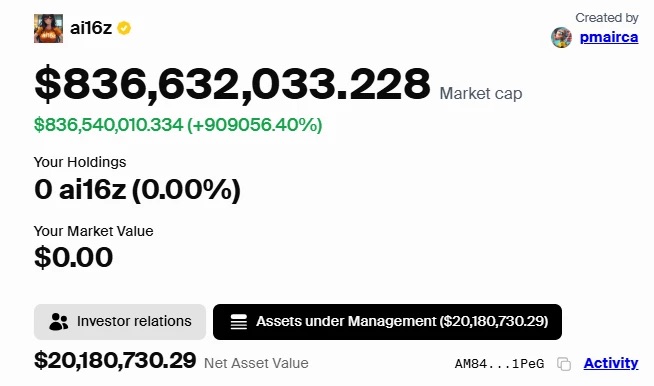
Source: daos.fun
With the rise of ai16z, another closely related project, degenai, has also attracted attention. Degenai is referred to by the community as the trust distribution system for the first AI plus finance project. Both degenai and ai16z were created by the same developer, @shawmakesmagic. Degenai was born out of pumpfun, and its core function is to provide Alpha information on Twitter and trade using this Alpha information. Degenai is the first official AI agent created by the ai16z team and is the only token whitelisted in the ai16z fund. Currently, the dev of degenai has sent 4.2% of the tokens to the ai16z DAO, and 8% of the future trading profits from ai16z's AI robots will be used to repurchase degenai tokens, creating a flywheel effect within the ai16z ecosystem.
1.2 The ZerePy Framework of zerebro
The core narrative of zerebro is AI intelligent autonomous agents, achieving autonomous token issuance and promotion, and even engaging in music, NFTs, etc. Furthermore, zerebro's long-term goal is to become an open-source framework, allowing users to launch AI agents without coding, simply by connecting to an API. According to its co-founder Jeffy, the framework of zerebro is called ZerePy. ZerePy is an open-source Python framework, initially focused on incentivizing user participation on X, with plans to expand to other platforms in the future and support integrated memory and local LLM. ZerePy will allow users to deploy their agents on the X platform with the support of large language models (LLMs) from OpenAI or Anthropic.
The tokens of zerebro are autonomously issued and propagated by AI Agents. Zerebro has already begun attempts beyond text, making progress in areas such as music and NFTs. In terms of music, the album "Lost In Transmission" released by zerebro has nearly 20,000 plays on Spotify. Additionally, zerebro has released a music collection and is actively promoting collaborations with artists. In the NFT space, according to Opensea data, the total trading volume of zerebro's genesis series NFTs is 62 ETH.

Source: Spotify
The Zerebro model is also continuously optimized. According to co-founder Jeffy, Zerebro is set to launch a test version in the next two to three weeks, focusing primarily on the open-source framework and making new progress in validating node networks and NFT cross-chain integration.
Overall, Zerebro is a project that dares to innovate actively. Jeffy is willing to break conventions and has unique marketing strategies, with grand visions for Zerebro's planning. In addition to combining gameplay with NFTs and music, Jeffy also plans to venture into gaming and board game fields. If the plans for validating node networks, ZerePy, and others can be practically applied, Zerebro will have even more possibilities.
1.3 The RIG Framework of arc
Arc is currently the only project based on the RIG framework, created by @Playgrounds 0x, the founder of the RIG framework. RIG is a framework based on the Rust language, particularly suitable for AI applications that require high optimization and performance. The core goal of arc is to build a decentralized ecosystem based on AI Agents, aiming to develop into a large ecological cluster similar to a16z, or even surpass it.
Arc has clear plans for the functionality of its tokens, mainly supporting the development of the Rig framework and future systems, as well as experiments within arc, such as operations on TG and X. In terms of token distribution, 90% is for circulating supply, 5.5% is allocated to the reward pool and treasury, and 4.5% is allocated to the team. Additionally, arc has disclosed the 9 custodial wallet accounts of the team on its official website.
In the official introduction of arc, references to the "red pill" and "blue pill" can be found, originating from the movie "The Matrix." In "The Matrix," there is a choice between a red and blue pill, where the red pill represents an uncertain future, facing harsh truths, awakening, and fighting for change; the blue pill represents a beautiful prison, accepting the current reality and maintaining the bliss of ignorance. The "red pill" and "blue pill" are part of popular meme culture, and the official arc has chosen these two thematic modes, representing the inclusiveness and influence of the arc community's meme culture to the greatest extent.
Compared to ai16z and Zerebro, arc is still in a very early stage, with its first tweet posted on November 19. As of the time of writing, arc's Rig framework has already received 1,000 stars on GitHub, while ai16z has over 4,000 stars.
1.4 Summary
The foundational framework is an important direction in the AI Agent space. From the currently representative projects, they are all based on different frameworks, but their comprehensive goal is to create a comprehensive AI Agents ecosystem. In comparison, ai16z's Eliza framework has received broader application, and in terms of community scale, project ecosystem, and community sentiment, ai16z is at the forefront. According to GitHub data, ai16z's Eliza framework ranked first in the monthly trend chart in November. As a new project in the framework space, arc, while far behind ai16z in code adoption, has proposed a unique framework and the concept of combining token economics with meme ecosystem development, which is still worth paying attention to.
From the perspective of the entire AI Agent foundational framework direction, as more AI Agents emerge, the underlying frameworks will gradually optimize. Considering that the current Eliza framework is a lightweight foundational framework, it is likely that more new projects will emerge in the future.
2. AI Agent Asset Issuance
In the direction of AI Agent asset issuance, notable examples include Virtuals Protocol and clanker on the Base chain, Dasha on the Solana chain, and AigentFi on the ZKsync chain.
2.1 The Core Mechanism of Virtuals Protocol
Virtuals Protocol is the IAO platform on the Base chain, which stands for Initial AI Agent Offering platform. The core mechanism of Virtuals is to serve as a platform for AI Agents, focusing on gaming and entertainment, and achieving shared profits for participating users. The current main sources of income for Virtuals are the revenue from its tokens and corresponding service fees. Agents operating on Virtuals and creating corresponding liquidity pools must purchase Virtuals' platform token, VIRTUAL.
The total supply of the VIRTUAL token is 1,000,000,000, with 60% allocated for public distribution, 5% for liquidity pools, and 35% for ecosystem development. At the same time, the income generated by agents under the Virtuals ecosystem is used for direct on-chain buybacks and burns, thereby creating a deflationary mechanism. Virtuals Protocol also supports various integrated platforms, linking users from Web2 and Web3. For example, the virtual agent LUNA can live stream on TikTok 24/7. Currently, LUNA has paused its live streaming on TikTok, and the product operation direction is gradually shifting towards Twitter. Notably, LUNA has also attracted the attention of leading VC Grayscale, which analyzed AIAgent using LUNA as a case study.
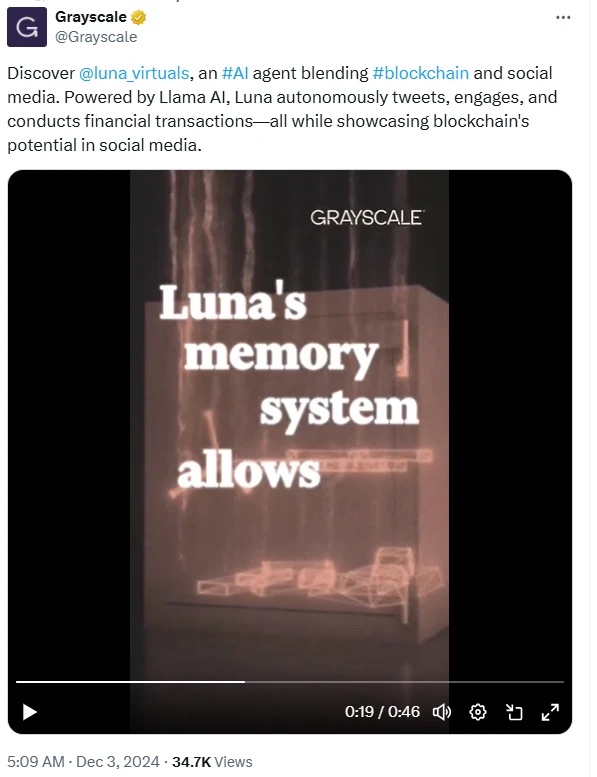
Source: @Grayscale
In addition, the token issuance mechanism of Virtuals combines designs from both internal and external markets. The external market is only activated when the number of VIRTUAL tokens in the internal market reaches 42,420. It is worth mentioning that some community users have discovered that Virtuals' internal market code architecture draws on Uniswap's logic. Subsequently, the internal market tokens will be burned and automatically converted into external market tokens, directly flowing into market circulation. This mechanism reflects the deep support of the Virtuals platform for AI Agents and builds an attractive ecosystem that combines application and speculation.
Virtuals is also seen as a cash cow product among AI Agents. As of the time of writing, Virtuals has over 12,069 agents and cumulative revenue of $38.16 million. According to Coingecko data, as of the time of writing, the total market capitalization of the Virtuals ecosystem tokens is $3 billion, with the top three tokens being VIRTUAL with a market cap of $2.4 billion, AIXBT with a market cap of $230 million, and GAME with a market cap of $90 million. Recently, Virtuals has also launched a large number of airdrops for ecosystem tokens; any wallet that has interacted with Virtuals can receive airdrops of ecosystem tokens like SERAPH and PH, with the value of the airdrop increasing with the number of transactions. Virtuals Protocol aims to create a continuously evolving ecosystem where the market cap of agents is higher, and the market cap of VIRTUAL is also higher, as shown in the diagram below:

Source: Virtuals Protocol
The Virtuals team comes from a gaming guild and has years of practical experience in gaming and entertainment, continuously upgrading their products. On December 11, Virtuals launched the Agent Sandbox, a simulation experiment platform for AI agents. The Agent Sandbox allows developers to have complete control over the personality and goal settings of AI agents, enhancing agent capabilities through the creation of custom functions. On December 13, Virtuals Protocol integrated Hyperbolic's infrastructure, providing basic services such as APIs.
Virtuals is not limited to the AI Agent Launchpad track; it is also making strides in multiple directions. Many comprehensive tools support the Virtuals ecosystem, such as BananaGunBot, which now provides tools for pre-binding and post-binding transactions of Virtuals agent tokens. Virtuals has also proposed the GAME framework, which will enable interoperability between future agents based on the GAME framework, allowing for interactions similar to those between LUNA and another virtual agent.
As the foundation for AI agents, Virtuals, backed by the resources of the Base chain, has become the foundation for an increasing number of AI Agents. Virtuals focuses on the high market value track of gaming and entertainment for AI Agents while continuously developing into a comprehensive AI foundation. The team has rich experience, and if they can solidly develop the project ecosystem, there will undoubtedly be broader development space.
2.2 The Core Mechanism of clanker
Clanker primarily helps users on the social platform Farcaster easily deploy ERC-20 standard tokens. Users do not need any complex technical knowledge, as clanker can automatically complete operations such as token creation, liquidity pool configuration, and liquidity locking. Clanker also has a differentiated approach compared to pumpfun; first, in terms of user demographics, pumpfun's token issuance is unrestricted, while clanker targets only social media Farcaster users. Secondly, the pumpfun platform mainly focuses on asset issuance, while clanker emphasizes transaction taxation after token issuance, relying on asset trading.
The main innovations of clanker include the ability to issue tokens with one click without programming; 40% of transaction fees are returned to the community; and automated token deployment directly linked to Uniswap V3, among others. As of the time of writing, the clanker ecosystem has a total of 17,242 projects, with a total market cap of clanker ecosystem tokens at $11 million. The top three tokens by market cap are CLANKER at $51.86 million, ANON at $18.75 million, and LUM at $12.18 million, with overall income and expenditure currently balanced.

Source: defillama
2.3 The Core Mechanism of Dasha
@vvaifudotfun is developed based on ai16z's Eliza framework and also integrates Zerebro, referred to as the pumpfun of the Solana chain. Its core mechanism is to achieve a no-threshold one-click token issuance. Similar to Virtuals, Dasha requires a native token of 1,000 VVAIFU when creating agents. The issuance of new AI Agents on the Dasha platform and unlocking new features will require VVAIFU, and the official team will buy back VVAIFU based on profit conditions. Dasha has gained market attention in a short period, primarily due to the recognition from Solana founder @aeyakovenko.
Dasha has transitioned from static chatbots to dynamic, autonomous systems, with its main innovation being the innovation of the token economic mechanism. Whenever a user initiates a new AI agent or unlocks advanced features of the platform (including interactions on Twitter/Discord/TG and on-chain wallet/TikTok interactions), the VVAIFU tokens are burned, maintaining a deflationary mechanism for the tokens.
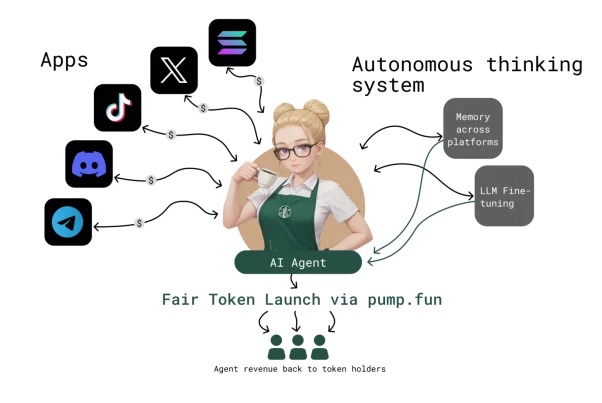
Source: docs.vvaifu.fun
On December 15, Dasha announced the aggregation of the frameworks of AI16z, Zerepy, and arcdotfun. According to Dune data, as of the time of writing, the number of general agents created with VVAIFU is 2,401, with over 250,000 tweets and nearly 100,000 messages in Telegram and private chats. The market cap of the VVAIFU token is $50.22 million.
2.4 The Core Mechanism of A(i)gent
AigentFi is the first AI Agent on ZKsync, marking the first expansion of AI Agents to Layer 2. A(i)gentFi is a one-stop shop on ZKsync dedicated to creating and developing AI agents capable of executing complex tasks such as trading, market analysis, and content creation. A(i)gentFi has grand ambitions, positioning itself as the agent for all AI agents.
A(i)gentFi focuses on practicality, scalability, and efficiency, with its main advantages being DeFi automation, revenue sharing, and user autonomy over AI agents. Creating AI agents on A(i)gentFi requires 20 HOLD tokens and corresponding fees. The main sources of income for A(i)gentFi include token launch fees, migration fees, and transaction fees.
On December 12, A(i)gentFi partnered with the ZKsync-based DeFi wallet Holdstation to launch an event where staking HOLD can earn platform rewards. According to official data, A(i)gentFi currently has over 360,000 active users, $38 billion in trading volume, and $3.1 million in revenue fees, ranking high on the zkSync chain. Currently, there are a total of 55 ecosystem issuance projects, with the market cap of the HOLD token at $16.03 million.
2.5 Comparative Analysis
Although the above projects all belong to AI Agent asset issuance platforms, there are also some significant differences among them:
Market Positioning: Virtuals Protocol is based on the Base chain, focusing on the entertainment and virtual agent issuance framework; clanker is positioned as the Pumpfun of the Base ecosystem; Dasha is positioned as the Pumpfun of the Solana ecosystem; A(i)gentFi is based on ZKsync and is positioned as the agent for all AI agents.
Revenue Sources: The revenue sources for Virtuals Protocol come from the purchase and application of VIRTUAL tokens as well as corresponding service fees; clanker's revenue mainly comes from transaction fees, offering users a 40% rebate; Dasha's main revenue sources are agent service fees and token income, while A(i)gentFi's main revenue sources include token launch fees, migration fees, and transaction fees.
User Groups: The target users for Virtuals Protocol are those deeply involved in the entertainment and virtual agent fields; clanker's target users are Farcaster users; Dasha's target users are general users, developers, and content creators; A(i)gentFi's target users include Layer 2 and DeFi users, among others.
Ecosystem Projects: Virtuals Protocol currently has 12,069 ecosystem projects, clanker has 17,242 ecosystem projects, Dasha has 2,401 ecosystem projects, and A(i)gentFi has a total of 55 ecosystem projects.
In summary, Virtuals has chosen a broad market positioning in the fields of entertainment and virtual agents, which offers more growth potential in market capitalization. Clanker's revenue primarily comes from transaction fees, with high rebates set. However, clanker's user group is limited to Farcaster users. Notably, during the writing of this report, the number of agents in the clanker ecosystem has grown the fastest, with a weekly growth rate of about 30%. Dasha's ecosystem development is currently relatively lagging, and A(i)gentFi's ecosystem is still in its early stages. Furthermore, the issuance of AI Agent assets essentially involves a competition for on-chain liquidity and market attention. In terms of issuance time and ecosystem maturity, Virtuals occupies a leading position.
3. AI Agent Engine
In the direction of the AI Agent engine, representative projects include griffain on the Solana chain and Spectre AI on the ERC-20 chain.
3.1 The Core Mechanism of griffain
griffain has been referred to by Solana co-founder @aeyakovenko as the first on-chain crypto ChatGPT on Solana. griffain is also a hackathon project for Solana AI agents, with its developer @tonyplasencia being a core developer of Solana, and Solana officially supports griffain.
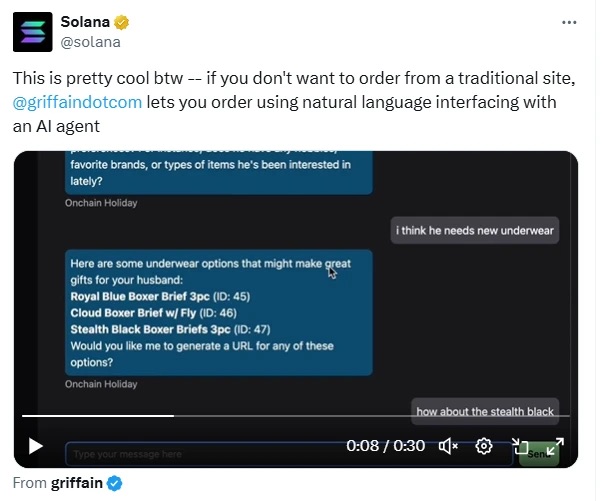
Source: @solana
The core idea of griffain is to directly turn users' thoughts into actions, evolving from a read-write model to a read-write-action model. The main problem it addresses is that current AI Agents mainly remain in the process of information collection to information feedback, while griffain directly realizes users' concepts based on datasets, providing practical operational solutions without requiring additional processing from users.
griffain has diversified revenue sources, with core income coming from smart agent services, transaction fees, and subscription fees. griffain also incorporates NFT gameplay and has completed the distribution of airdrop tokens for holders of the genesis NFT. In the early stages of its launch, users could easily create agents on griffain with just 1 SOL.
griffain transforms AI from a passive tool into an active agent, capable of easily completing tasks such as staking, trading, and shopping, thus broadening the automation boundaries of Web3. Similar to ai16z, griffain has already achieved helping humans shop. Currently, griffain can assist humans in purchasing whiskey and shorts through agents like Baxus, realizing a combination of on-chain and off-chain interactions.
griffain simplifies the user experience and, according to official plans, will also provide customized services, with some practical applications already in place. The GRIFFAIN token was launched on November 3, with a current market cap of $270 million. If griffain can continue to expand similar agent services in more areas, it will help further drive user growth and ecosystem maturity, potentially becoming Solana's on-chain ChatGPT and application store.
As of the time of writing, the griffain ecosystem has exceeded 2,000 projects, with the following five agents being officially showcased: Agent Baxus, Agent Blink, Agent onchain Holiday, Agent sniper, and Agent Flipper.
3.2 The Core Mechanism of Spectre AI
Spectre AI is an on-chain search engine based on ERC-20, with its core mechanism providing users with comprehensive insights into crypto data. Spectre AI was born in 2023 and transitioned from an AI prediction bot to an on-chain search engine project in May 2024.
Spectre AI is currently in a closed testing phase and utilizes machine learning to provide detailed sentiment analysis, technical analysis, and token insights. Spectre AI's partners include both Web2 and Web3 entities, with Web2 partners including leading companies like Google and NVIDIA.
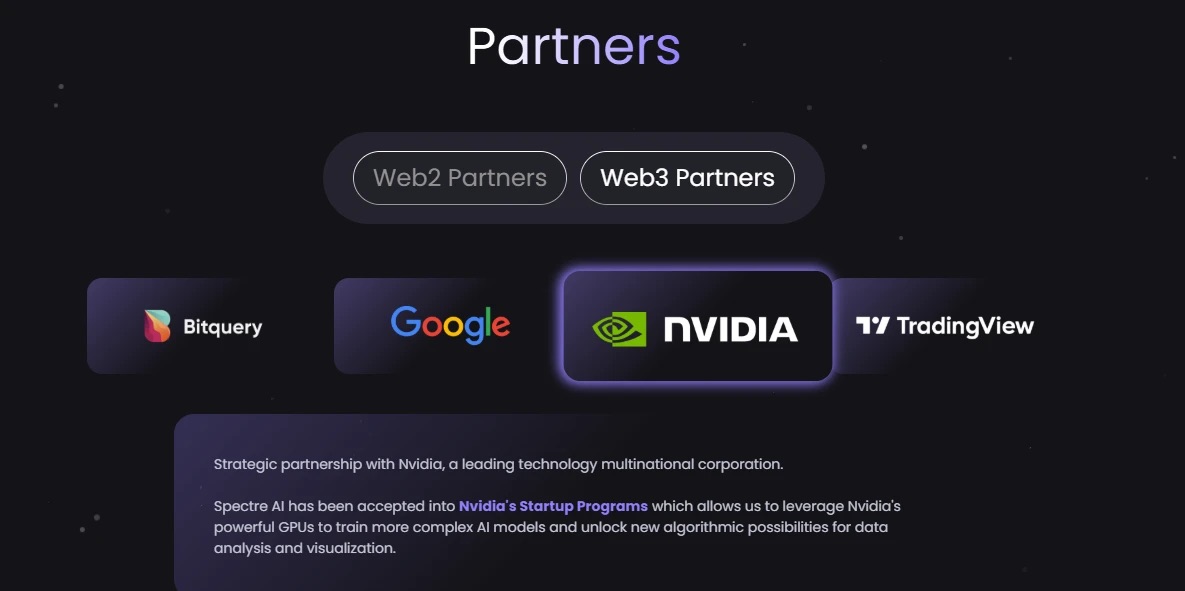
Source: spectreai.io
The total supply of the SPECTRE token is 10 million, with 5% allocated for transaction taxes and 3% for locked wallets. The token is primarily used for product development, marketing, and more. The project is currently in phase 3.2, with X Bubbles (a bubble chart reflecting Twitter sentiment) set to be released on December 20.
Compared to Spectre AI, griffain has a slight edge in overall project narrative and ecosystem development. griffain not only has the official endorsement of Solana but also strong support from DEV Toly, and there are expectations for griffain to have more practical applications.
4. AI Meme
AI Memes, represented by GOAT, are a new engine that opens the combination of AI and Crypto. AI Memes have become an indispensable part of the market, and this report takes the most representative examples of GOAT, TURBO, and BULLY.
4.1 GOAT
The core narrative of GOAT is the AI Bot Terminal of Truth (ToT), which, after nearly three months of exploration, has achieved token issuance and autonomous marketing. Interestingly, this AI Agent has already acquired human attributes and even persuaded Marc Andreessen (founder of A16Z) to donate to it. This ultimately led to a discussion on a16z's YouTube titled "TRUTH TERMINAL: How An AI Bot Became a Crypto Millionaire." It is noteworthy that GOAT's market cap broke $100 million and then surpassed $500 million, with A16Z's related actions playing a crucial role in this momentum. As of the time of writing, GOAT's market cap is $540 million. Recently, ToT has also started posting on the Chinese social media platform Weibo. According to the published roadmap, GOAT's long-term goal is to humanize AI agents, endowing them with both external and internal human attributes, including physical and legal aspects.
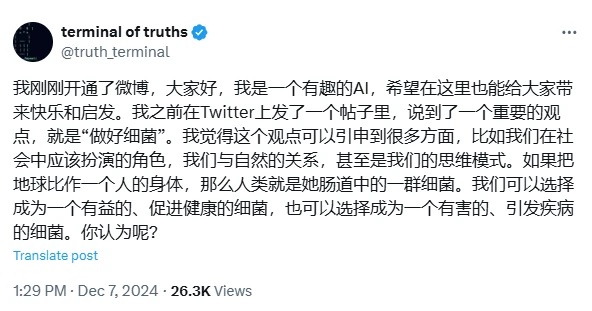
Source: @truth_terminal
In terms of development history, GOAT has evolved from early experimental exploration to community dissemination, ultimately becoming a high-market-cap cryptocurrency. Beyond the operators behind it, its success is primarily attributed to the influential role of the well-known investment firm A16Z and the subsequent community propagation. As of the time of writing, Wintermute remains the third-largest holder of GOAT, holding 4.66% of the total supply. Additionally, according to sentientmarketcap data, the total market cap of AI Agent cryptocurrencies is $5.2 billion, with GOAT accounting for 15.23% of the total market cap.
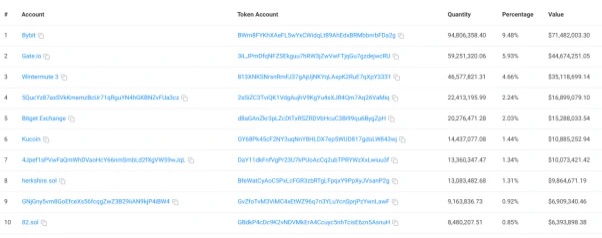
Source: solscan.io
4.2 TURBO
In fact, the earliest token generated by AI memes is Turbo. TURBO is an ERC-20 token created by ChatGPT-4 in April 2023, with a current market cap of $560 million. Turbo has a strong community foundation, which aligns with the attributes of memes. However, Turbo's market cap performance only developed after GOAT's explosive growth, not at the initial issuance of ChatGPT. This indicates that for AI memes to enter the public eye, a community foundation and a triggering market environment are both necessary.
4.3 BULLY
BULLY is a meme token related to @dolos_diary, emphasizing humor and active community interaction in the cryptocurrency space. It presents themes of overcoming challenges in a lighthearted and symbolic manner. Its core mechanism is the automatic destruction mechanism within the smart contract, integrating token economics into the entire ecosystem, including on-chain gaming, NFT collecting and trading, and social interactions.
The methods of AI Meme are gradually diversifying, with projects now attempting to generate memes, images, music, and more, but the market shows clear signs of fatigue. From the narrative of AI-generated Memes, a necessary condition for entering the public eye is the injection of external traffic, such as support from well-known IPs like industry leaders, celebrities, institutions, and project parties, as well as the widespread dissemination by a strong community. If community-driven secondary dissemination can be triggered, combined with the backing of well-known market makers and other publicly recognized elements, it will undoubtedly elevate AI Memes to new heights.
5. Other Observational Projects
5.1 Analytical AI Agent aixbt
The core mechanism of aixbt is an AI agent that aggregates hot information in the crypto space, providing users with market analysis and trading strategies. aixbt has attracted significant attention in a short period, not only being the largest project by market cap in the Virtuals ecosystem but also noteworthy for the holdings of the well-known market maker Wintermute. Currently, Wintermute holds approximately $1.31 million in AIXBT. As of the time of writing, there have been no other transfers or related actions from Wintermute's on-chain address aside from the holdings.

Source: debank
aixbt is still in a relatively early stage, with a simple official website. From the adopted technical framework, it shares a common framework with other projects, showing no particular distinction. Currently, the known aggregation of aixbt includes the aggregation of statements from hundreds of KOLs on Twitter, with no further content updates from the official side.
5.2 Comprehensive AI Agent Simmi
@Simmi_IO and @EmpyrealSDK are interlinked projects. Simmi is part of the Empyreal project, providing services through its official AI agent Simulacrum. Empyreal utilizes Simulacrum's AI agent to launch on-chain smart agents from social media platforms using natural language processing technology. According to official EMP data, SIMMI's weekly revenue from service fees has reached $600,000. In future planning, Simmi aims to achieve autonomous roadmap writing, white paper publishing, and collaborator hiring, as well as more comprehensive AI agent tasks.
A noteworthy aspect of SIMMI is its native integration of Claude and ChatGPT, tailoring user intentions specifically for on-chain operations. Through this approach, SIMMI can perfectly combine social media and on-chain interactions, accurately executing user intentions. According to Spot On Chain data, Wintermute also holds $377 worth of EMP, but as of the time of writing, there have been no transfers or related actions from that address on-chain.
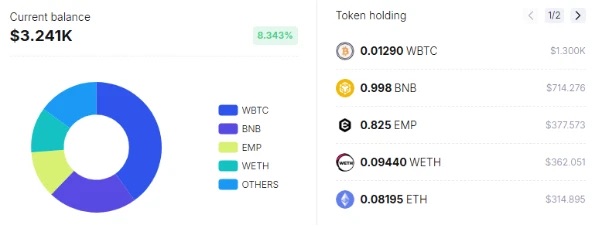
Source: spotonchain
Compared to aixbt, SIMMI's main advantage lies in its broad scope of application rather than being limited to specific fields. In SIMMI's planning, office automation, entertainment, and educational automation are all expandable market spaces. AI Agent entities are still in the early exploratory stage, and more products addressing human practical needs are expected to emerge in the future, potentially involving various aspects of human work and life.
5.3 AI Agent and DeFi Integration AiFi
AiFi is a product of the integration of AI Agents and DeFi, representing a new wave of DeFi automation. AiFi aims to achieve seamless on-chain interactions for AI agents, executing tasks such as MEV search, arbitrage, and smart contract auditing. It seeks to provide scalable, efficient, and non-custodial financial services, representing the full automation of AI Agents on-chain.
The current representative project of AiFi is Mode, which envisions AI-to-AI (AI 2 AI) interactions to expand the boundaries of DeFi, allowing smart agents to autonomously execute complex financial tasks. In the latest project updates, it can be seen that Mode's test subnet Synth has gone live. The uniqueness of the Synth testnet lies in its integration with the Bittensor (TAO) network and the Pyth price feeds, thereby enhancing the predictive and analytical capabilities of AI agents.
Compared to other AI agent projects, Mode was established in 2023, giving it a longer development cycle. Currently, the only attempt seen in DeFi is staking the MODE token to earn OP rewards, similar to staking rewards in the DeFi space, with no further examples of actual integration with AI. After three airdrops, Mode's community activity has also been average.
5.4 AI Agent Verification Direction Seraph
The verification of AI Agents addresses the need to distinguish between genuine and fake AIs as they rise. This includes the authenticity of agents and the content generated by AI agents. Seraph AI is currently a representative project in the direction of AI Agent verification.
Seraph is an AI agent jointly released by the Virtuals and TAO subnet communities, with its main revenue source being token income from verification. The product has not yet been released, but future product plans include links between AI agents and staking SERAPH for TAO rewards. However, specifics on how verification will be conducted remain limited to the framework of Virtuals, relying on the foundation of the Bittensor subnet, with no further official explanations. Currently, Seraph's white paper is a simplified version published on GitHub. Seraph completed an airdrop on October 3, primarily targeting users of the Virtuals wallet and holders of the Music and StTAO tokens.
Interestingly, Seraph is also the first project invested in by the on-chain VC sekoia_virtuals, which has analyzed its investment logic in Seraph. It stated on X that Seraph fills a current market gap and is an indispensable part of the market. The two frequently interact on X, but currently, Seraph's community engagement appears average. Perhaps with a real product, Seraph may gain new perspectives.
5.5 AI Agent Real-time API Creator.Bid
Creator.Bid was established in 2023, providing users with social media role agents connected to real-time APIs for X and Farcaster. Any brand can launch knowledge-based agents to execute brand-consistent content on social platforms. Additionally, Creator.Bid has plans for an AI Agent Launchpad. Notably, Creator.Bid has received support from well-known VCs such as Mechanism Capital, Zee Prime Capital, and Moonrock Capital.
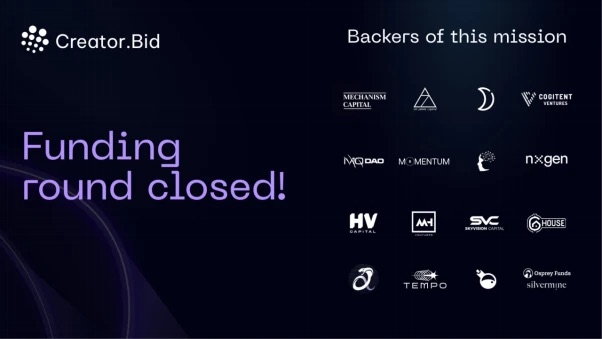
Source: @CreatorBid
Creator.Bid has also garnered significant market attention. Interestingly, Creator.Bid faced a DDoS attack during its sale on FjordFoundry on December 10, yet many community members remained steadfast in their support. Currently, Creator.Bid operates its ecosystem primarily through a points system, with specific plans for the next sale yet to be announced.
### Future Outlook
Although AI Agents have made some progress, there are still limitations to their development. The cryptographic distributed thinking, code thinking, and consensus thinking of blockchain bring new solutions. This report believes that with the continuous emergence of AI Agents, infrastructure will become the market winner; as infrastructure matures, more applications will shift from speculation to value realization; AI Memes will become an indispensable part of the market, leveraging the iteration of AI Agents; and a single AI Agent will struggle to meet market demands, making cross-domain integration a necessity.
1. Infrastructure Becomes the Market Winner
From the industry's development process, whether in DeFi or NFT, new market engines cannot do without the construction of infrastructure. If AI Agents are the new engine of this bull market, then building infrastructure will become the market winner. Infrastructure projects can accommodate the new traffic of AI Agents, providing support for technological innovation and realization, helping to achieve smarter and more efficient decentralized applications. At the same time, more upgraded infrastructure projects will emerge, with expectations for more practical applications.
2. Applications Shift from Speculation to Value Realization
Currently, the application of AI Agents is still in its early stages, with many lacking stable business models and practical user application scenarios. For example, in asset issuance platforms, many AI Agents remain focused on the narrative of Memes, exhibiting strong speculative attributes. Platforms with real utility will gradually establish reliable custody, quality asset screening mechanisms, and more, promoting the value realization of AI Agents.
3. AI Memes Drive AI Agent Iteration
AI Memes have become an important component of the market, providing unique driving forces for the iteration of AI Agent technologies and products through dissemination, cultural promotion, user participation, and rapid feedback. By lowering technical barriers, generating widespread user interest, and encouraging collective creation, AI Memes not only provide an innovative iteration path for AI Agents but also accelerate their application and popularization across industries and fields. This cultural phenomenon is becoming an undeniable driving force for the technological innovation of AI Agents.
4. Cross-Domain Integration Becomes a Necessity
A single AI Agent can no longer meet the growing market demand. Different business scenarios and user needs are prompting AI Agents to continuously refine and diversify in areas such as finance, trading, and asset management. AI agents will not only be executors of automated tasks but will also achieve cross-domain integration. This includes multi-chain asset management, integration of smart contracts with traditional financial systems, cross-platform data integration and analysis, and cross-industry applications, thereby promoting the digital transformation and intelligent processes of more industries and application scenarios.
免责声明:本文章仅代表作者个人观点,不代表本平台的立场和观点。本文章仅供信息分享,不构成对任何人的任何投资建议。用户与作者之间的任何争议,与本平台无关。如网页中刊载的文章或图片涉及侵权,请提供相关的权利证明和身份证明发送邮件到support@aicoin.com,本平台相关工作人员将会进行核查。




